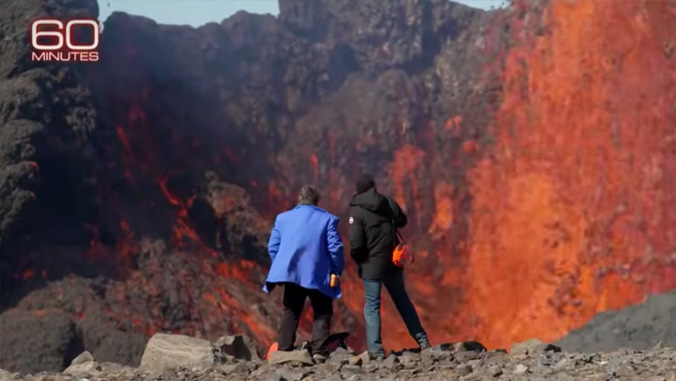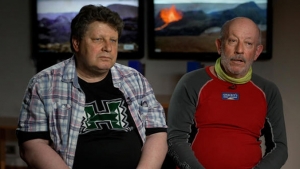
A new volcano, Geldingadalir, has erupted in Iceland, offering rare opportunities for close-up exploration and research into eruption processes and how to better predict future eruptions. 60 Minutes correspondent Bill Whitaker talked with University of Hawaiʻi at Mānoa School of Ocean and Earth Science and Technology (SOEST) alumni Thorvaldur Thordarson and Christopher Hamilton, and Earth sciences Professor Bruce Houghton, during the eruption response.
- 60 Minutes: Iceland’s newest volcano offers rare opportunities
- 60 Minutes: Iceland’s newest volcano provides insight into Mars
Opportunity knocks

After a drastic decline in volcanic activity from the Halemaʻumaʻu lava lake on Kīlauea Volcano by April 2021 and with no access to the Italian volcano Stromboli during the COVID-19 pandemic, Houghton connected with Thordarson, who is now a professor in volcanology and petrology at the University of Iceland to find a new target for his research.
Given their robust working partnership and the dynamic and rapidly changing character of the eruption on the Reykjanes Peninsula in Iceland, the two researchers developed a plan to capture high resolution videos of the Reykjanes fountains to quantify the changing patterns of eruption style and strength and link this to drone-based studies of the evolving craters, lavas and cones.
When Houghton arrived at the volcano, he witnessed a spectacular sight.
“These were easily the best, most breath-taking fountaining eruptions that I have ever seen,” said Houghton. “Conditions were perfect for documenting their activity—we could approach safely to the very edge of any part of the system of linked lavas and cones and had driving access to many key observation points.”
Now back in Hawaiʻi with the video footage in hand, Houghton and UH researcher Caroline Tisdale will measure key parameters like eruption rate, particle sizes and velocities that determine the style and intensity of these unusual eruptions, which sit in the middle ground between Hawaiian lava fountains and short-lived explosions such as Stromboli.
The collaboration continues to provide new insights into the mechanisms affecting when, why and how basaltic volcanoes erupt. This information feeds directly into hazard and impact studies that are particularly important, in light of the 2018 eruptions and devastation at Kīlauea.
This event is an example of UH Mānoa’s goal of Excellence in Research: Advancing the Research and Creative Work Enterprise (PDF), one of four goals identified in the 2015–25 Strategic Plan (PDF), updated in December 2020.
For more information, see SOEST’s website.
–By Marcie Grabowski

